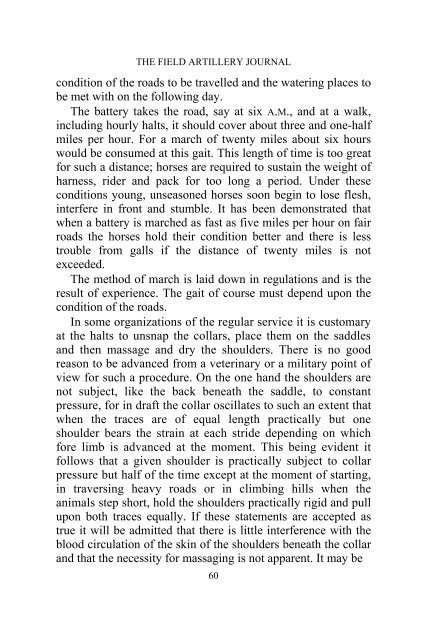the field artillery journal - Fort Sill - U.S. Army
the field artillery journal - Fort Sill - U.S. Army
the field artillery journal - Fort Sill - U.S. Army
You also want an ePaper? Increase the reach of your titles
YUMPU automatically turns print PDFs into web optimized ePapers that Google loves.
THE FIELD ARTILLERY JOURNAL<br />
condition of <strong>the</strong> roads to be travelled and <strong>the</strong> watering places to<br />
be met with on <strong>the</strong> following day.<br />
The battery takes <strong>the</strong> road, say at six A.M., and at a walk,<br />
including hourly halts, it should cover about three and one-half<br />
miles per hour. For a march of twenty miles about six hours<br />
would be consumed at this gait. This length of time is too great<br />
for such a distance; horses are required to sustain <strong>the</strong> weight of<br />
harness, rider and pack for too long a period. Under <strong>the</strong>se<br />
conditions young, unseasoned horses soon begin to lose flesh,<br />
interfere in front and stumble. It has been demonstrated that<br />
when a battery is marched as fast as five miles per hour on fair<br />
roads <strong>the</strong> horses hold <strong>the</strong>ir condition better and <strong>the</strong>re is less<br />
trouble from galls if <strong>the</strong> distance of twenty miles is not<br />
exceeded.<br />
The method of march is laid down in regulations and is <strong>the</strong><br />
result of experience. The gait of course must depend upon <strong>the</strong><br />
condition of <strong>the</strong> roads.<br />
In some organizations of <strong>the</strong> regular service it is customary<br />
at <strong>the</strong> halts to unsnap <strong>the</strong> collars, place <strong>the</strong>m on <strong>the</strong> saddles<br />
and <strong>the</strong>n massage and dry <strong>the</strong> shoulders. There is no good<br />
reason to be advanced from a veterinary or a military point of<br />
view for such a procedure. On <strong>the</strong> one hand <strong>the</strong> shoulders are<br />
not subject, like <strong>the</strong> back beneath <strong>the</strong> saddle, to constant<br />
pressure, for in draft <strong>the</strong> collar oscillates to such an extent that<br />
when <strong>the</strong> traces are of equal length practically but one<br />
shoulder bears <strong>the</strong> strain at each stride depending on which<br />
fore limb is advanced at <strong>the</strong> moment. This being evident it<br />
follows that a given shoulder is practically subject to collar<br />
pressure but half of <strong>the</strong> time except at <strong>the</strong> moment of starting,<br />
in traversing heavy roads or in climbing hills when <strong>the</strong><br />
animals step short, hold <strong>the</strong> shoulders practically rigid and pull<br />
upon both traces equally. If <strong>the</strong>se statements are accepted as<br />
true it will be admitted that <strong>the</strong>re is little interference with <strong>the</strong><br />
blood circulation of <strong>the</strong> skin of <strong>the</strong> shoulders beneath <strong>the</strong> collar<br />
and that <strong>the</strong> necessity for massaging is not apparent. It may be<br />
60

















